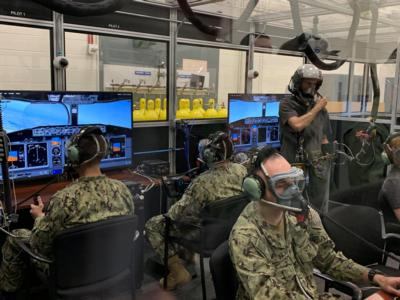Thu, Jun 10, 2021
Former Methods Often Caused Decompression And Barotrauma Sickness
The Naval Aviation Training Systems and Ranges program office (PMA-205) Normobaric Hypoxia Trainer (NHT) team recently designed, delivered, installed, and began support of the NHT at Naval Air Station (NAS) Patuxent River, the first trainer of its kind eliminating common hypoxia training injuries.

The legacy Low Pressure Chamber trainer used in hypoxia training for pilots and aircrew often caused decompression and barotrauma sickness, the leading causal factors for training injuries in the Naval Aviation Survival Training Program (NASTP). The NHT team, made up of an expert group of research engineers and scientists, looking to mitigate those injuries, developed the NHT concept.
“With the critical and innovative work of our NHT team, we no longer need to worry about barotrauma during cold and sinus season that caused trapped gas pain and injury in our fixed wing non-ejection seat aircrew students at the Aviation Survival Training Centers,” said Cmdr. Andy “Lurch” Hayes, NASTP integrated project team lead. “Inside safety observers no longer need to administer nasal decongestants or perform the invasive Politzer maneuver to inflate the middle ear and sinuses by injecting compressed air up one nostril while the other was closed.”
The NHT design not only eliminates the risk of barotrauma and decompression sickness, but it also can simulate high altitude flight while accommodating up to 12 personnel including six aircrew and two pilot/co-pilot teams monitored by two inside observers. Borrowed from the success of students trained on the Reduced Oxygen Breathing Device, the team included flight simulators and controls to add realism and allow aircrew to practice Emergency Procedures (EP) specific to their Naval Air Training and Operating Procedures Standardization aircraft. This is the first time in naval aviation history that fixed wing non-ejection seat pilots are able to practice EPs in a state of hypoxia.
“Gone are the days of patty cake in the chamber to monitor hypoxia symptoms. We are fortunate to have the aviation physiology expertise on our team that creatively developed a training system that allows the aircrew to experience hypoxia in a safe environment while conducting aviation operator tasks,” said Capt. Lisa Sullivan, PMA-205 program manager.
More News
Very High Frequency The frequency band between 30 and 300 MHz. Portions of this band, 108 to 118 MHz, are used for certain NAVAIDs; 118 to 136 MHz are used for civil air/ground voi>[...]
Aero Linx: Aviation Suppliers Association Established February 25, 1993, the Aviation Suppliers Association (ASA), based in Washington, D.C., is a not-for-profit association, repre>[...]
Have A Story That NEEDS To Be Featured On Aero-News? Here’s How To Submit A Story To Our Team Some of the greatest new stories ANN has ever covered have been submitted by our>[...]
From 2021 (YouTube Version): Colorado Campus Offers aVariety Of Aerospace Entertainment And Education Wings over the Rockies Exploration of Flight is the second location for the Wi>[...]
Also: Paramotor Champ's, Electric Ultralight, ICON BK Update, Burt Rutan at Oshkosh! The Popular Rotorcraft Association is reaching out for help in rebuilding their private runway >[...]
 ANN's Daily Aero-Term (05.17.24): Very High Frequency
ANN's Daily Aero-Term (05.17.24): Very High Frequency ANN's Daily Aero-Linx (05.17.24)
ANN's Daily Aero-Linx (05.17.24) ANN FAQ: Submit a News Story!
ANN FAQ: Submit a News Story! Classic Aero-TV: ANN Visits Wings Over The Rockies Exploration Of Flight
Classic Aero-TV: ANN Visits Wings Over The Rockies Exploration Of Flight Airborne Affordable Flyers 05.16.24: PRA Runway, Wag-Aero Sold, Young Eagles
Airborne Affordable Flyers 05.16.24: PRA Runway, Wag-Aero Sold, Young Eagles



